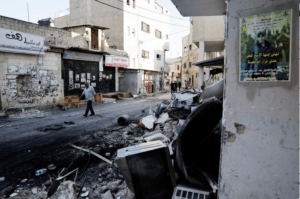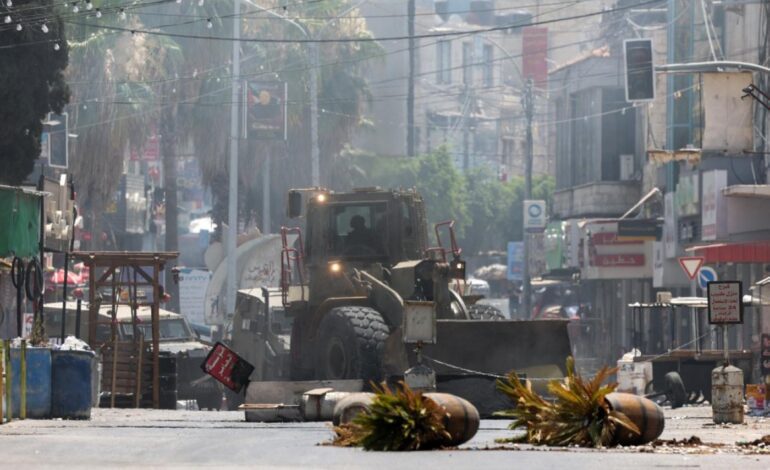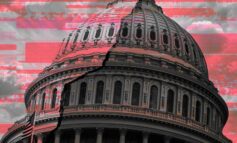Americans celebrate their independence on the Fourth of July. It is a celebration of freedom, patriotism and American heroes. While we were here celebrating our independence from another country, an ongoing battle lasted over two days in Jenin between Palestinian resistance fighters and Israeli occupying forces.
The Jenin refugee camp has been in the Western spotlight for the last 20 years. Since the Second Intifada, Jenin has been known as a stronghold for Palestinian resistance fighters defying Israeli occupation forces. You know what, I’ll say it. Most American conservatives would say that Jenin, specifically its camp, has become a terrorist hot spot.
Daily raids carried out by Israeli occupation forces have become regular life for Palestinians in Jenin over the previous 24 months. Israeli forces have killed more than 100 Palestinians in Jenin since 2022, a city that had a population of under 40,000 people in 2007.
Over 4,000 Palestinians have been forced to flee their homes in Jenin since the latest attack that started Sunday evening U.S. time. At least 12 Palestinians have been killed, over 100 others have been wounded, some of them critically, and many Palestinian homes and infrastructure have been demolished.
Over 4,000 Palestinians have been forced to flee their homes in Jenin since the latest attack that started Sunday evening U.S. time. At least 12 Palestinians have been killed, over 100 others have been wounded, some of them critically, and many Palestinian homes and infrastructure have been demolished.
The Jenin refugee camp has transformed into a fortress over the past few years. Palestinians are forced to make their way through steel barriers installed by Israeli forces, security cameras, and concrete checkpoints.
The camp was established in 1953 by the United Nations Agency for Palestine Refugees, UNRWA. The Jenin camp accommodated Palestinians displaced during the 1948 war when the State of Israel was created. The camp’s population was part of 700,000 Palestinians who were forced to abandon their homes by Israeli forces and Zionist militias.
The Jenin camp covers an area of approximately 0.42 kilometers on the edge of Jenin. It was originally designed to be a temporary settlement. Generations of Palestinians have been forced to live through hardships that accompany living under occupation. The camp has become a permanent home for many people facing challenges from limited space, restricted access to basic services and the constant agony of living under direct surveillance.
Strained resources and poor living conditions created by overcrowding have made daily life unbearable for many of the camp’s residents as the population has grown over the generations. A lack of adequate housing, reliable electricity supply and proper sanitation facilities produce circumstances we can’t fully comprehend while living in the United States in July 2023.
According to the UNRWA, over 23,000 Palestinians, more than 7,000 children, called the Jenin camp home before the recent attack.

Palestinians walk on the street after the Israeli army’s withdrawal from the Jenin camp, in Jenin, in the Israeli-occupied West Bank July 5. – Photo by Reuters
Western governments have closely watched the Jenin camp since the Second Intifada. It has been “a thorn in the side of the occupation” ever since.
The Israeli occupation forces launched a full-on assault on the Jenin camp in 2002. Israeli officials claimed the camp had become a “launching pad for resistance activities.” Significant Israeli forces deployed against Palestinian resistance fighters. The intense fighting lasted for 10 days. According to the United Nations, 52 Palestinians and at least 23 Israeli soldiers were killed.
Human Rights Watch reports that Israeli forces killed 27 resistance fighters and at least 22 Palestinian civilians. Israeli officials constantly repeat that the “expressed aim was to capture and kill Palestinian militants.”
Following over 48 hours of intense fighting in the Jenin camp since the most recent attack, Al Mayadeen reported that the “Palestinian people are returning to the Jenin camp after the occupation forces withdrew from it, and the resistance fighters are roaming the streets.”
Multiple Israeli media outlets quote a spokesperson for the Israeli occupation forces as saying, “Israeli forces have begun withdrawing from Jenin.”
According to Israeli Channel 7 and Channel 13, “The violent clashes near Jenin Hospital forced the army to evacuate the area with air support.”
The Al-Quds Brigades – Jenin Brigade confirmed that Palestinian resistance fighters were still targeting occupation forces and vehicles in several areas throughout Jenin.
According to reports from Al Mayadeen, a field commander in the Al-Quds Brigades in the Jenin camp said occupation forces were attacked by Palestinian freedom fighters using IEDS and small arms.
The commander said, “The scale and intensity of the confrontations on the second day were fierce and direct, with the freedom fighters detonating new explosive devices, including powerful roadside bombs.
“Our forces opened fire and prevented the advancement of occupation soldiers, dealing damages to and causing casualties among the enemy forces,” he continued.
As an American journalist covering the West Bank, two thoughts dominated my thinking as everything unfolded in the Jenein camp on our Fourth of July. I kept thinking of all the rubble from demolished homes and infrastructure I’d seen in videos and pictures.
According to the Middle East Eye, an eyewitness reporter with Al Araby TV said, “The scenes on Monday morning were quite literally terrifying. I was with my colleagues in the Jenin camp, and we were the only camera people in the place.
“The only way to describe the scenes is an earthquake. It looked like an earthquake had struck the Jenin camp. The roads were completely obliterated, ambulances could not get through, and wounded people had to walk,” he continued.
I kept thinking about recent pictures I saw from Gaza. The same rubble and wreckage have been there for over 20 years. Nothing has been done to rebuild anything. Is the same thing going to happen with the Jenin camp?
Things were already horrible enough. I’ve watched video footage in the last 12 hours of Israeli military bulldozers ripping up the pavement from streets in the Jenin camp to purposefully explode water lines. How and when does all of this get fixed? Why would anyone be surprised if the next two generations of Palestinians in Jenin grow up hating Israel even more than the current generation of resistance?
I also spent a lot of time thinking about what the Fourth of July means to us as Americans. When did resistance turn from patriotism to terrorism for Americans? What made continental freedom fighters in 1775 different than Palestinian resistance fighters in 2023? I was raised believing being willing to sacrifice your life for your country was not only patriotic but also heroic, regardless of religion.
I am sure that many countries throughout Europe considered our “patriots” as terrorists in the mid-1770s. Our American freedom fighters were willing to give their lives to ensure that my daughter and I have the freedoms we do today. Personally, I know Palestinian teenagers and young adults who are part of the Palestinian resistance and have more in common with Paul Revere than grown conservative American men.
I get it. Many Americans will say that American freedom fighters didn’t kill innocent people. They weren’t attacking British civilians to make a political statement. That is because they couldn’t. The colonial colonies were being occupied by a foreign power on another continent, not the other side of a concrete wall.
Still, if that had been the only way, if George Washington’s men had to put British civilians’ lives in danger, I hope they would have pushed things as far as they needed to. I enjoy the freedoms we have as Americans today. I don’t see how thinking that way makes me a terrorist.
As Americans, who are we to say that Palestinian resistance fighters willing to give their lives to defend their camp from a full-fledged attack is wrong? It’s as if American patriots are all for other people fighting for their freedom as long as we get to tell them what it means to resist.
— Jeffery Stevens is a freelance journalist and a contributor to The Arab American News.






Leave a Reply